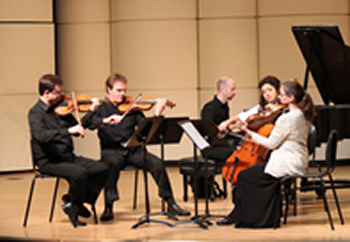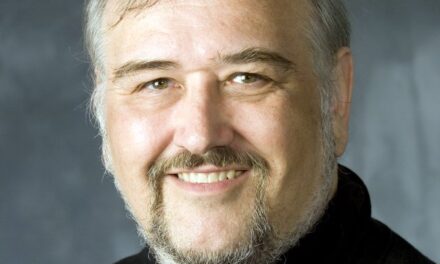The Duke Performances Series in cooperation with the Chamber Arts Society of Durham presented the Isidore String Quartet in recital on Saturday, December 3, 2022 in Baldwin Auditorium. The ISQ are Adrian Steele, Phoenix Avalon, Devin Moore, and Joshua McClendon. ISQ is the chosen laureate ensemble of the 2022 Banff International String Quartet Competition. Their program, subtitled “The Awakening Program” featured works of Franz Joseph Haydn, Billy Childs and Ludwig van Beethoven, engaging the audience in a deeply introspective musical experience.
The opening work was the second of the set of six Haydn Op. 20 quartets of 1771 (which marks a significant “awakening” of expressive and sonic “architecture”) and defines the very nature of the string quartet in formal structure and performance tradition. One example of Haydn’s innovations includes writing for the cello in a higher melodic range – two octaves above its traditional bassline role. The closing movement also uses the fugal process, deviating from the use of dances or sonata-allegro formal treatment. The innovative prowess and exploration heard in these quartets led the philosopher Goethe to describe this human interplay between all four instruments as “the conversation of four intelligent people.”
The middle work of the program, Billy Childs‘ String Quartet No. 2 Awakening (2012) pulled the audience in much deeper than the aforementioned “rational conversations” of Haydn. Violinist Avalon gave verbal comments about biographical connotations in the work’s subtitle: this three-movement work was composed in the wake of the emergency hospitalization of the composer’s wife ten years ago due to a pulmonary embolism. The opening movement, “Wake Up Call” captures the shock, fear, and uncertainty at the news of the emergency and extensive hospitalization. The middle movement, “The White Room” confines the listener within the disembodied sonic experience of a hospital room with only monitoring machines beeping and singing in a disjunct yet ironically choreographic expression: the powerlessness, urgency and “incarcerated patience” of such moments hold the listener “emotional hostage.” The third movement, “Song of Healing” is a fittingly thankful song and an “ode to discovery and recovery” shared between the violin and cello as a musical expression of the deeply meaningful conversations had between husband and wife during the hospital stay and afterward. Awakening was composed for and premiered by the Ying Quartet.
The remainder of the program was verbally dedicated to the late violinist Geoff Nuttall who was leader (“prima inter pares“) of the St. Lawrence String Quartet, who passed away on October 22 at age 56 after battling pancreatic cancer.
Beethoven’s String Quartet No.15 in A minor, Op. 132 the program and the “Awakening” theme with a late work of the composer whose life and work still influences our notions of the Romantic style and expression in music. Our gathered sense and celebration of memory (nostalgia), responses to literary expressions in visual art, painting, sculpture, drama and even dance can all be appreciated considering Beethoven’s creative influence as explored in his middle and late-period works. The Opus 132 string quartet dates from 1825, a turbulent year in his life: the near-complete deafness of two decades before, a serious bowel inflammation requiring surgery, and the ongoing emotional drama with his nephew Karl who attempted suicide while a university student in Vienna. His late quartets are characterized by flowing contrasts and contradictions. The opening two movements consist of a tersely expressed yet extensive manner of instrumental “dialogue” – quite the contrast of the “educated conversation” so admired by Goethe in Haydn’s quartet writing. Shifts of melodic center, phrase length, key scheme, dynamics – and the “surprising reprises” in the first two movements – creating a unique sense of sonic architecture that might better resemble the main portal of La Sagrada Família cathedral in Barcelona, Spain!
The central third movement bears the lengthy subtitle “Heiliger Dankgesang eines Genesenen an die Gottheit, in der lydische Tonart” (Song of Thanks to the Deity by one who has recovered, in the Lydian Mode). A hymn flowing in canon unfolds pristinely with interior variations, this movement is regarded as one of the most beautiful, ethereally expressed moments in chamber music. This movement forms the unique core of the work – and “corona” of the program’s title and theme, “Awakening and Reawakening.” The creation of such an otherworldly musical dialogue on an instrumental level exceeds even Goethe’s notion of educated dialogue: it is “unspoken expression flowing in a private moment yet a shared place of experience,” the concert. In the “Billy Childs-ian sense,” the “Heiliger Dankgesang” is the individual response to the conversational “Song of Healing”– surely Goethe would appreciate that parallelism!! However, the “Song of Healing” and “Heiliger Dankgesang” are not expressions of the chatroom, but of the prayer closet. The fourth movement is surprisingly brief – it’s a march that proceeds forward but never arrives at its destination. Its brevity is dwarfed by the fifth and final movement, which is a waltz introduced by a brief recitative like the finale of the Ninth Symphony. Those aforementioned “Goethian conversations” are subjected to a “wisp of a waltz seemingly too large and too long” but still infused with that resurgent creative heroism that distinguishes his late-period works.
A standing ovation by the audience greeted the musicians at the concert’s end; the Contrapunctus I from The Art of Fugue (BWV 1080) by Johann Sebastian Bach was given as a fitting encore.
Upon entering and exiting the stage all four gentlemen walked with a curiously ponderous gait. They “moved in absence of hurry” unlike chamber musicians of earlier decades who took to the stage as if they were restaurant waiters in a hurry to serve and please an audience of customers. They took their time, telegraphing to the audience the gravity of the musical program awaiting them. If the audience was puzzled by such an entry, the meaning and significance of such movement was clear by the end. The Isidores’ performance was a moving start to an auspicious premiere tour, a fine program to awaken and reawaken audiences to the beauty and joy of hearing chamber music.












